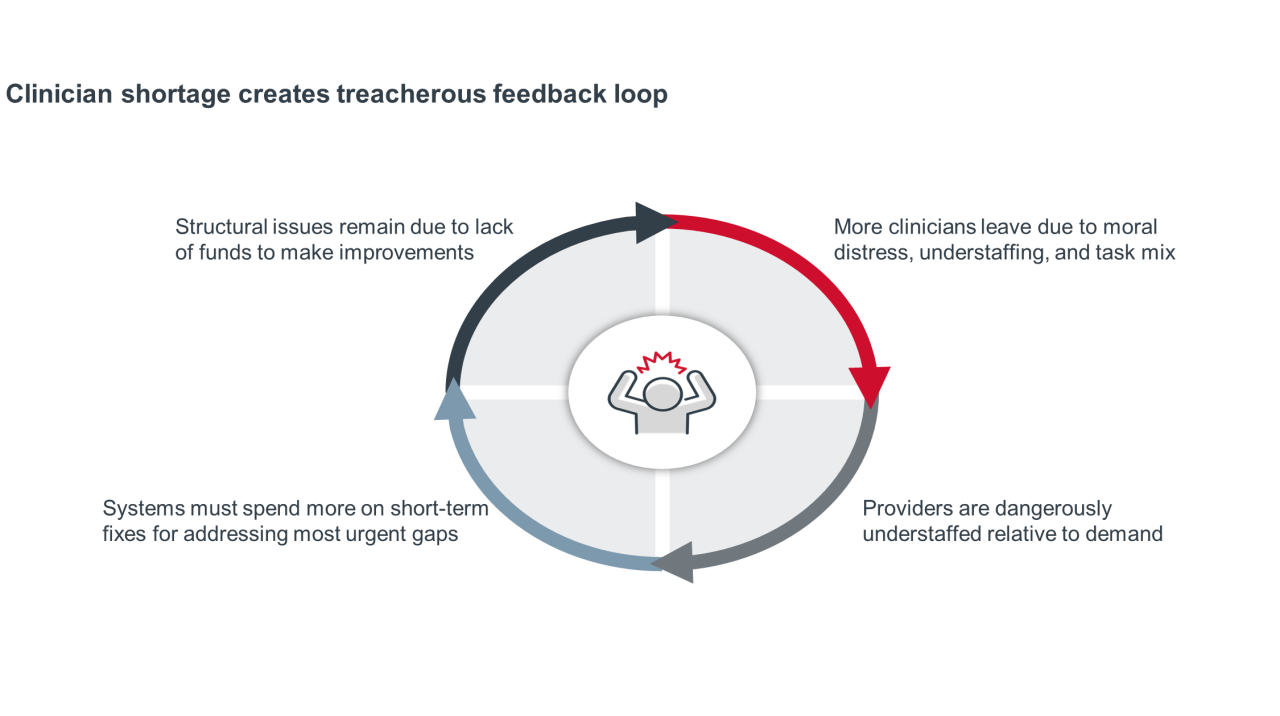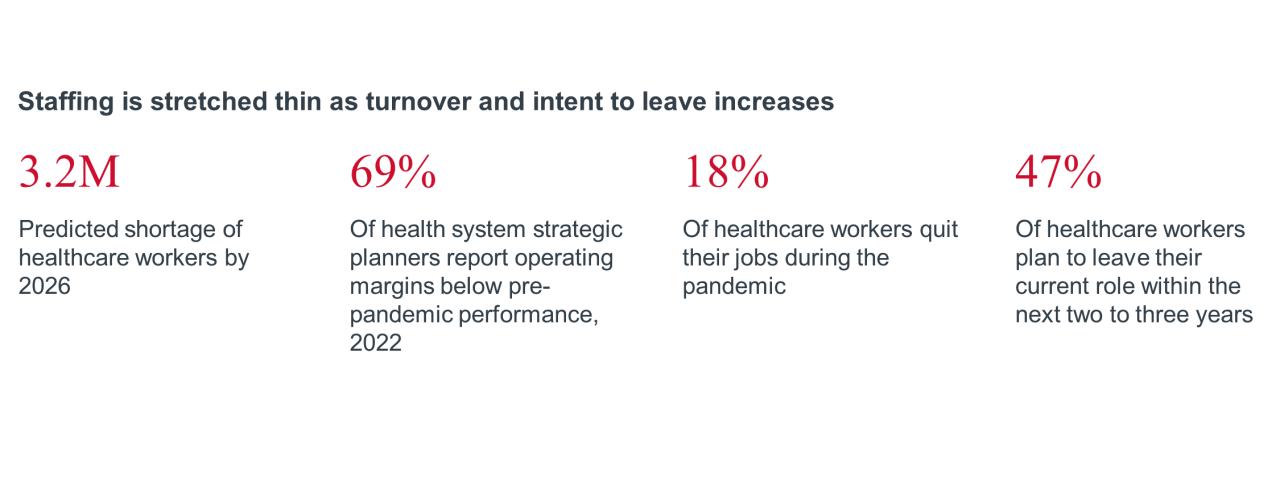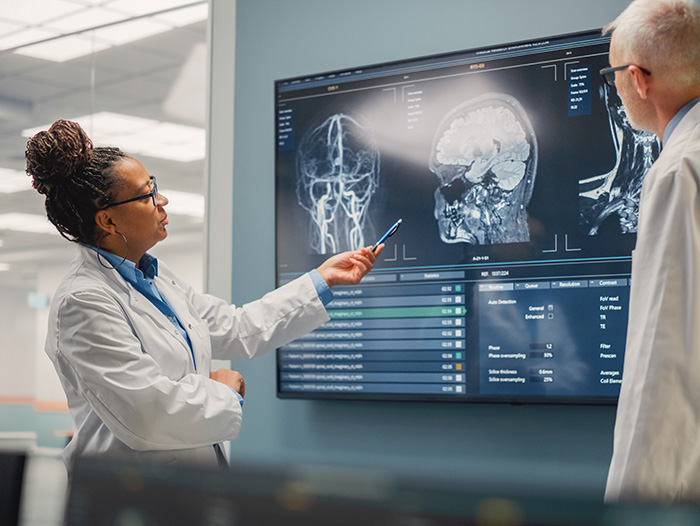Auto logout in seconds.
Continue LogoutClinical workforce technology includes any tech-enabled solutions designed to impact clinicians’ workflows and improve efficiency. Although technology’s implementation sometimes causes unintended effects, such as increased documentation burden after the implementation of EHRs, the purpose of clinical workforce technology is to make clinicians’ lives easier and their work better.
Technology geared towards clinicians usually falls into two main buckets:
- Technology that improves productivity: Technology can offload repetitive tasks, such as charting, and streamline communication between clinicians. These solutions increase efficiency by reducing time spent on low-level tasks and allowing clinicians to work at top-of-license. Example technologies include:
- Ambient listening that transcribes office visits and reduces time spent on charting and documentation
- Clinical communication that facilitates better collaboration between clinicians to improve coordination and fewer errors from miscommunication
- Robotic assistants that complete low-level tasks like distributing food trays, pharmaceuticals, and lab samples
- Ambient listening that transcribes office visits and reduces time spent on charting and documentation
- Technology that supports clinical decision-making and performance: This type of technology alerts clinicians or presents them with relevant patient data to make better care decisions. These tools reduce the amount of time spent on assessments, creating treatment plans, making diagnoses, and increase diagnosis and treatment accuracy. Example technologies include:
- Decision support tools that include alerts, order sets, care pathways, risk-assessment systems, and context driven information displays.
- Predictive analytics that identify the likelihood of medical outcomes and inform preventative treatment plans
Leaders need technology to address healthcare's most pressing challenges - the workforce crisis. The crisis is a result of a vicious cycle: Narrow margins make it difficult to prioritize investments in the workforce. Increasing administrative and cognitive burden lead to burnout and moral distress. Clinicians leave, driving a workforce shortage. Provider organizations feel an urgency to fill the gaps, and rely on short-term, costly fixes, like contract labor and overtime pay, that further drain the organization of resources.

The workforce crisis will not end soon. The pandemic only exacerbated tensions in the workforce, and now many clinicians are weighing whether to remain at the bedside or exit healthcare altogether. Leaders can’t hire their way out of this: the labor pool is small and it’s expensive to rely on contract labor. Downstream effects of the workforce crisis, like unsustainable labor costs and a decrease in patient safety and care quality, are costly for health systems—and will only get worse if change doesn’t happen. It’s too expensive to not invest in technology.

There’s untapped potential for technology to change the trajectory of the healthcare workforce. Technology has become increasingly reliable and effective within the last few years; functions that seemed futuristic are now possible today. Now is the time for leaders to take advantage of technological capabilities to support clinicians.
By improving productivity and supporting clinical decision-making, clinicians can benefit from the downstream effects of technology – extending clinical reach and improving the work environment for clinicians. Here are seven ways clinicians can benefit:
Potential benefits of clinical workforce technology:
- Save clinicians time: Technology that takes on burdensome and time-consuming administrative tasks, such as charting and prior authorization, frees up clinicians’ time. Clinicians can use that time to focus on patient care without being weighed down by non-clinical tasks. These solutions also present an opportunity for a better work-life balance, like going home on time instead of spending off-hours on documentation. This outcome improves the wellbeing of clinicians and drives a better work environment.
- Reduce information overload: As patient care becomes more complex and documentation increases; technology can assist by parsing through the data to pull relevant information. This empowers clinicians to focus on making well-informed clinical decisions, which reduces cognitive burden and burnout and improves performance.
- Increase flexible work arrangements: An increase in technology like remote monitoring and virtual visits can open doors for more flexible work arrangements for clinicians. For example, clinicians can take visits from home during off-hours or clinicians considering retirement can shift to a virtual role. These possibilities increase work-life balance, drive down burnout, and even enables some workers to remain in the workforce when they otherwise would
- Support newer, less experienced clinicians: Tenured clinicians or clinicians close to retirement can shift to virtual mentor role on virtual learning platforms to provide extra education and training for newer clinicians. This allows for clinicians to feel more supported and assists with closing the experience gap.
- Improve patient-clinician relationships: Clinicians are better able to focus on patients’ needs when technology takes over non-clinical, administrative tasks like routine questionnaires and note-taking during a visit. This maximizes the time clinicians spend on the issues that matter to patients and helps clinicians focus on the meaningful work they want to do.
- Improve quality of care: Technology can reduce the likelihood of medical errors and improve diagnoses and treatment decisions. Sample opportunities for quality improvement include eliminating miscommunication and highlighting the most relevant information to a patient’s case. In turn, care quality and patient safety increases, which reduces feelings of moral distress amongst clinicians and reinforces clinician support.
- Recruit and retain staff: Clinicians increasingly expect technology to have the same impact in their work that it has in all other aspects of their lives. Organizations who have invested in technology to address the workforce crisis will remain more competitive in the labor pool.
How do workforce challenges manifest at your organization? Which roles or care settings need the most support?
How can you use existing resources to support your workforce? Where are there gaps and where could technology help?
Who are you including in the decision-making process, especially when it comes to investments in technology?
How will you measure success and the impact of technological interventions on your workforce?
Advisory Board’s Marissa Goodall and Giorgio Piatti contributed to this research.
Don't miss out on the latest Advisory Board insights
Create your free account to access 1 resource, including the latest research and webinars.
Want access without creating an account?
You have 1 free members-only resource remaining this month.
1 free members-only resources remaining
1 free members-only resources remaining
You've reached your limit of free insights
Become a member to access all of Advisory Board's resources, events, and experts
Never miss out on the latest innovative health care content tailored to you.
Benefits include:
You've reached your limit of free insights
Become a member to access all of Advisory Board's resources, events, and experts
Never miss out on the latest innovative health care content tailored to you.
Benefits include:
This content is available through your Curated Research partnership with Advisory Board. Click on ‘view this resource’ to read the full piece
Email ask@advisory.com to learn more
Click on ‘Become a Member’ to learn about the benefits of a Full-Access partnership with Advisory Board
Never miss out on the latest innovative health care content tailored to you.
Benefits Include:
This is for members only. Learn more.
Click on ‘Become a Member’ to learn about the benefits of a Full-Access partnership with Advisory Board
Never miss out on the latest innovative health care content tailored to you.



